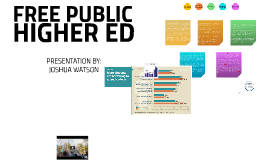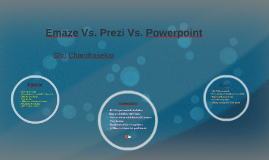FREE PUBLIC
Transcript: HIGHER ED Methodologies Discussion Findings * Free public higher education has been a controversial topic amongst state and national government in regards to the progressions or regressions that it may produce. * However, the very thought of bringing it to the table may be something worth considering at the table. * This research seeks to examine discourse around the topics on free public higher education (FPHE) and what the advantages would look like in modern day society. *There will be discourse around FPHE as a social innovation and how the very idea of social innovation can set the agenda for education reform in the United States. Progress University of Baltimore - "Finish4Free" Tennessee - Push for Free Two Year Colleges Oregon - Free Higher Ed paid through wages * Examinations of literature (newspaper and journal articles, press releases, social media, petitions, and books) focused around the topic of achieving a FPHE was conducted (February-April of 2014). * Literature on this topic was very one sided and I was not successful in my pursuit to find literature focused around anti-FPHE, therefore, highlighted the discourse on challenges to a FPHE within the literature reviews examined. * I engaged in email to a San Francisco State University Professor who is a member of the California Teachers Association (CTA) currently working on a campaign to create FPHE across the nation. * In the 1970’s, the Federal Pell Grant covered 80% of college costs. For the 2013-2014 academic years, the Federal Pell Grant only covered 31% of college costs. What has changed over this time span? In a time where highly educated citizenry is needed, what progress are we making towards achieving that? * “If we took the state and federal money already being spent on providing higher education and the state and federal money that is lost each year due to higher education tax credits, deductions, and shelters, we could make public higher education free for millions of Americans.” – Bob Samuels * Redirecting tax subsidies seems like a possible solution to evading high student debt payments. However, new approached on how student debt can be subsidized may be near. In a recent article by the Roosevelt Institute, “how we subsidize student debt in a similar way to mortgage debt, that is, through allowing people to deduce the interest paid on this debt from taxes,” may be a fixer (Konczal, 2011). * Student debt is higher than ever with ranging numbers from $28,000-$33,000 being the average debt for college graduates and is increasing each year. * Student debt negatively impacts financial flexibility, buying power, and economic freedom. *Reducing or eliminating student debt would allow recent alumni to invest in their future such as purchasing homes, etc. *High student debt could be used to build wealth to evade poverty. *Policies progressing towards a Free Public Higher Education or more affordable higher education will address the national student debt crisis for future college students and the current economy. Conclusion * For-profit institutions such as the Apollo Group, University of Phoenix, EDMC, and Corinthians College contribute to the national student debt. 94% of the bachelor recipients in these for-profit institutions borrow to finance their higher education, with 23% defaulting on their loans. These for-profit institutions account for nearly one half of all student loan defaults. * “the public will give up on the idea of educating people for democratic citizenship, Instead, all of public higher education will be essentially vocational in nature, oriented entirely around the market logic of job preparation (Glenn, 2010).” * The United States is one of the 10 member organizations that has signed the United Nations’ International Covenant on Economic, Social, and Cultural Rights but has not ratified it. Is education making inequality worse? - For-profit institutions should be tasking their administrators to lead the way in social innovation/ entrepreneurship to combat high student debt and defaults. Governments should take into account that privatization of education will only enhance plutocracy and polarization that will cause for public and not-for-profit universities to dwindle. -As it stands now, cuts are constantly being made to higher education due to increasing costs of Medicaid, K-12 education (which isn’t bad, but they are suffering too), and prisons. -If the United States is seeking to push towards a free higher education system, they should ratify the United Nations’ International Covenant on Economic, Social, and Cultural Rights as a progressive step forward. Talk is cheap, literally. FREE PUBLIC Overview PRESENTATION BY: JOSHUA WATSON Conceptual Framework

















